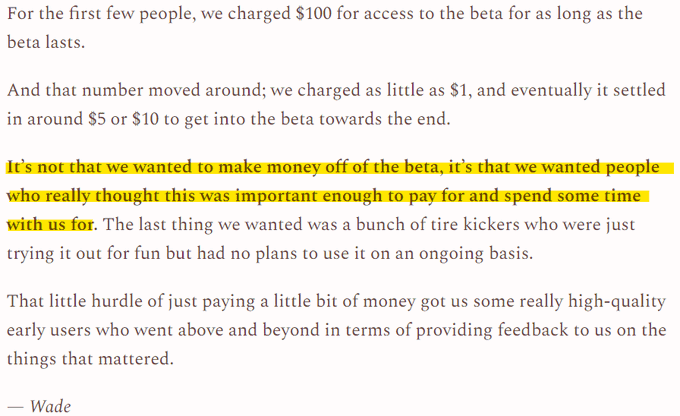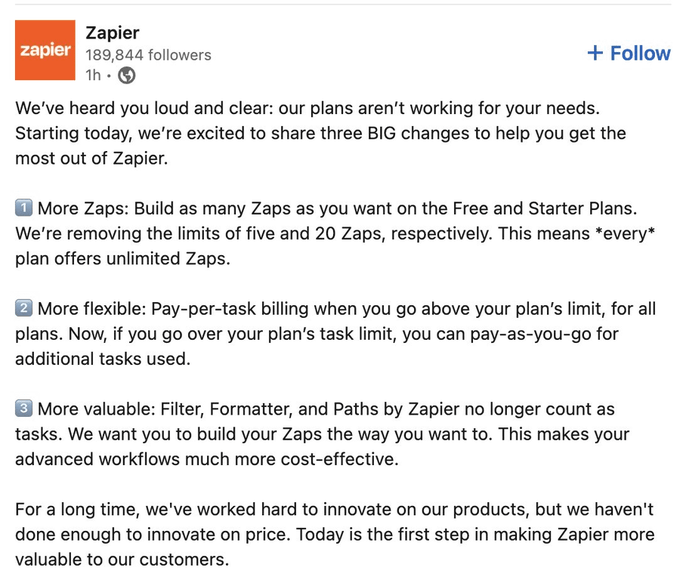Have you heard of Zapier, a company considering getting web apps to "talk to each other"?
The above 3 fellas are the founders of this company. In June 2011, they created a prototype in just two days at a weekend hackathon.
Since then the company:
- Has over 100K customers
- Made $250M in revenue
- Employs over 1K people
- Currently valued at $5B
Here's how it all started, let's deep dive into their amazing story.
Just a quick reminder, here is a link to my Medium list which includes all founder stories I have written to this date. Thanks
How this all started

Back in 2009, Wade Foster (person in the middle) was doing his day job but wanted to start his own company. He didn't know if he had the skills at 24 years old to make it happen.
Around the same time, Foster also re-connected with college jazz enthusiast, and friend, Bryan Helmig (person on the right). They began freelancing together in their spare time while pitching ideas back and forth.
Wade's job required him to constantly connect different software programs.
After spending 8 months manually forcing emails, databases, and customer loans to sync, the big idea eventually came!

Idea creation and its marketing
The main idea was simple: "To connect all the technology tools people use so people can do it with ease."
For this, the duo then recruited Mike Knoop, another friend from college, and Zapier was born.
For the next 6 months, they balanced their day jobs and late-night coding sessions up until 3 AM. Finally, they made the first prototype in a startup weekend hackathon.
Now it was time for one of the hardest challenges, which is bringing in new users. Here's how they bring in Zapier's very first user.
While Helmig and Knoop were iterating the prototype, Wade started marketing it.
He visited help forums of popular products like Evernote, Salesforce, and Dropbox to see what integrations customers were requesting.

However, Wade knew this growth strategy was not scalable. So, he scheduled as many Skype calls as possible and asked customers which products they wanted to integrate and would manually assist with each one.
These calls began to take shape in Zapier's culture of customer support.
The earliest versions of Zapier broke all the time, but it was a learning experience. Wade sat with every customer who complained throughout the call and made the problem get fixed.
That level of service for early customers surprised a lot of people.
Because their customer relationship was great, they got people to pay to try their unfinished product. The reason behind this was that the team at Zapier wanted serious customers who gave them specific feedback on which things weren't working out.

Designing and becoming part of the YC summer
After talking to tons of folks, the trio had improved the UI and UX so they didn't have to manually onboard people anymore. People figured out how to use the thing.
By December 2011, Zapier had gained 10K users on the launch list and 25 integrations with different popular sites.

About that same time was when they'd applied and gotten into YC Summer 2012. The three co-founders quit their day jobs. For the next three months, the trio did nothing other than write code, build products, and talk to users.

To scale Zapier to the next level, the trio started focusing on getting more apps. The idea was if they had an integration for an app, that opened up a new potential market for them.
Hence they invested heavily in the developer platform and onboarded as many apps as they could.

Because they were ruthlessly adding more apps.
The team found a way to use SEO to capture traffic, setting up landing pages for as many app-to-app connections as possible so that Zapier would show up in search results as shown below:

They had a landing page for every integration Zapier supports. As they added more and more apps, there were N plus one more opportunities for landing pages.
And that search volume added up over time.

How is Zapier going
One thing that made early inroads for Zapier and continues to do so today is how they put customers at their highest priority. Recently customers requested Zapier to start charging "pay-per-task" instead of only monthly subscriptions.
And they did just that:

Everyone at Zapier has a common job, which is customer support.
The benefit of having everyone (even engineers) spending time speaking to customers directly sharpened their product thinking.
The team became far more customer-centric since day 1 and the culture continues to thrive.

Lesson: When attracting users, make it as easy as possible to help them understand how your products help them. All that initial effort (especially SEO) can easily compound.
I hope you learned something valuable from the above founder story, also do share your opinion about the Zapier system and processes. 👇
If you like this content and it resonates, please Subscribe to me for more. Also, check out my Blog here to explore more. I appreciate it.
Ali.

